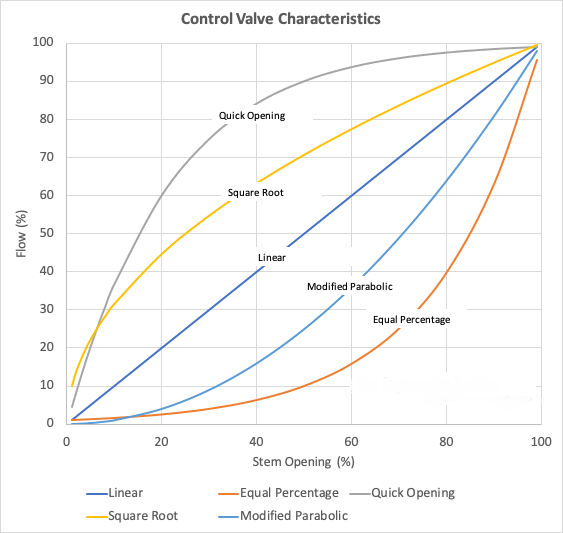The flow characteristic in a control valve refers to the relationship between the valve's opening (or travel) and the flow rate through the valve. Understanding and selecting the correct flow characteristic is crucial for ensuring optimal performance, system stability, and efficient operation in industrial processes. If the wrong flow characteristic is chosen, it can lead to undesirable outcomes, such as instability in the control loop or inefficiency in fluid regulation. This article explores the key flow characteristics commonly found in control valves, their applications, and the impact of these characteristics on system performance.
Flow characteristics are central to the operation of control valves, which are used to regulate fluid flow in various industrial applications. The flow characteristic defines how the flow rate changes in relation to the valve stem position. Different types of flow characteristics are suited to different applications based on the needs of the system, such as maintaining a constant flow rate, compensating for varying pressure drops, or providing rapid changes in flow rate.
Control valves can be designed with different flow characteristics, each optimized for specific types of control loops. Selecting the appropriate characteristic is critical for achieving smooth and stable operation, especially in processes that require precise regulation of flow and pressure.

The primary types of flow characteristics in control valves include:
Quick-Opening Characteristic
Linear Characteristic
Equal-Percentage Characteristic
Modified Parabolic Characteristic
Hyperbolic and Square Root Characteristics
Each of these characteristics has a distinct impact on how the valve operates and interacts with the system. Below, we will examine each characteristic in detail, including its typical applications and benefits.
The quick-opening flow characteristic is designed to produce a maximum change in flow rate with minimal valve travel. In this configuration, the valve provides a nearly linear relationship between flow rate and valve travel at lower travel positions, meaning that small adjustments in the valve stem position result in large changes in flow. However, as the valve opens further, the flow rate begins to increase at a much slower pace, and when the valve nears the fully open position, the flow rate change approaches zero.
This characteristic is ideal for applications where a rapid change in flow is required, such as in on-off control systems. It is also used in some processes where high valve gain is acceptable or where the system requires significant flow changes in a short time. However, quick-opening valves are generally not suitable for modulating or precise control applications due to their highly nonlinear behavior at higher openings.
Applications: Quick-opening valves are commonly used in applications where the flow needs to be quickly turned on or off, such as in batch processes, sequential operations, or other semi-continuous processes.
In the linear flow characteristic, the flow rate increases directly in proportion to the valve travel. This means that the flow rate increases at a constant rate as the valve opens, producing a straight-line relationship between valve position and flow rate. The linear characteristic is ideal when a constant gain is needed across the entire range of the valve's travel.
This characteristic is most commonly used in applications where a consistent and predictable flow is required. For example, in liquid level control systems or flow control applications that require constant valve gain, a linear characteristic ensures that changes in flow are evenly distributed as the valve adjusts.
Applications: The linear characteristic is used in applications such as liquid level control and constant flow rate regulation, where a stable, proportional relationship between flow rate and valve travel is essential.
The equal-percentage flow characteristic is one of the most commonly used flow characteristics in control valves. In this configuration, equal increments of valve travel produce equal percentage changes in the flow rate. This results in an exponential increase in flow rate as the valve opens. The equal-percentage characteristic is highly beneficial in situations where the pressure drop across the valve is not constant and may vary significantly throughout the process.
This characteristic is typically used in pressure control applications and other systems where most of the pressure drop is absorbed by the system itself, with only a small portion of the pressure drop occurring across the valve. It is also ideal for situations where the pressure drop changes drastically during operation, as it helps to maintain stable flow regulation despite these fluctuations.
Applications: The equal-percentage characteristic is well-suited for applications where pressure control is important or where varying pressure conditions are expected, such as in steam systems or systems with fluctuating pressure drops.
This characteristic is commonly used in process control applications where a range of flow rates is required, and the operator needs to maintain fine control at lower flow rates while still achieving linearity at higher flows.
Applications: Modified parabolic characteristics are often used in general process control systems, where both fine throttling at low flows and linearity at higher flows are needed.
The most common inherent flow characteristics are:
These inherent characteristics are determined by the design of the valve trim, and manufacturers often provide characteristic curves for each type of valve to help engineers select the right valve for a specific application.
When actual flow is plotted against valve opening in a system, the resulting curve is known as the installed flow characteristic. This curve can be significantly different from the inherent characteristic, particularly when there are significant changes in the system's pressure drop or when the valve is used in dynamic conditions. Understanding the installed flow characteristic is crucial for optimizing control performance, as it provides a more accurate representation of how the valve will behave under actual operating conditions.
Control valve manufacturers provide detailed characteristic curves to help engineers make informed decisions, and understanding how these curves shift between inherent and installed characteristics is crucial for optimizing control systems. By selecting the appropriate flow characteristic, operators can achieve more stable and efficient flow regulation, improving overall system performance and minimizing the risk of instability or inefficiency.
